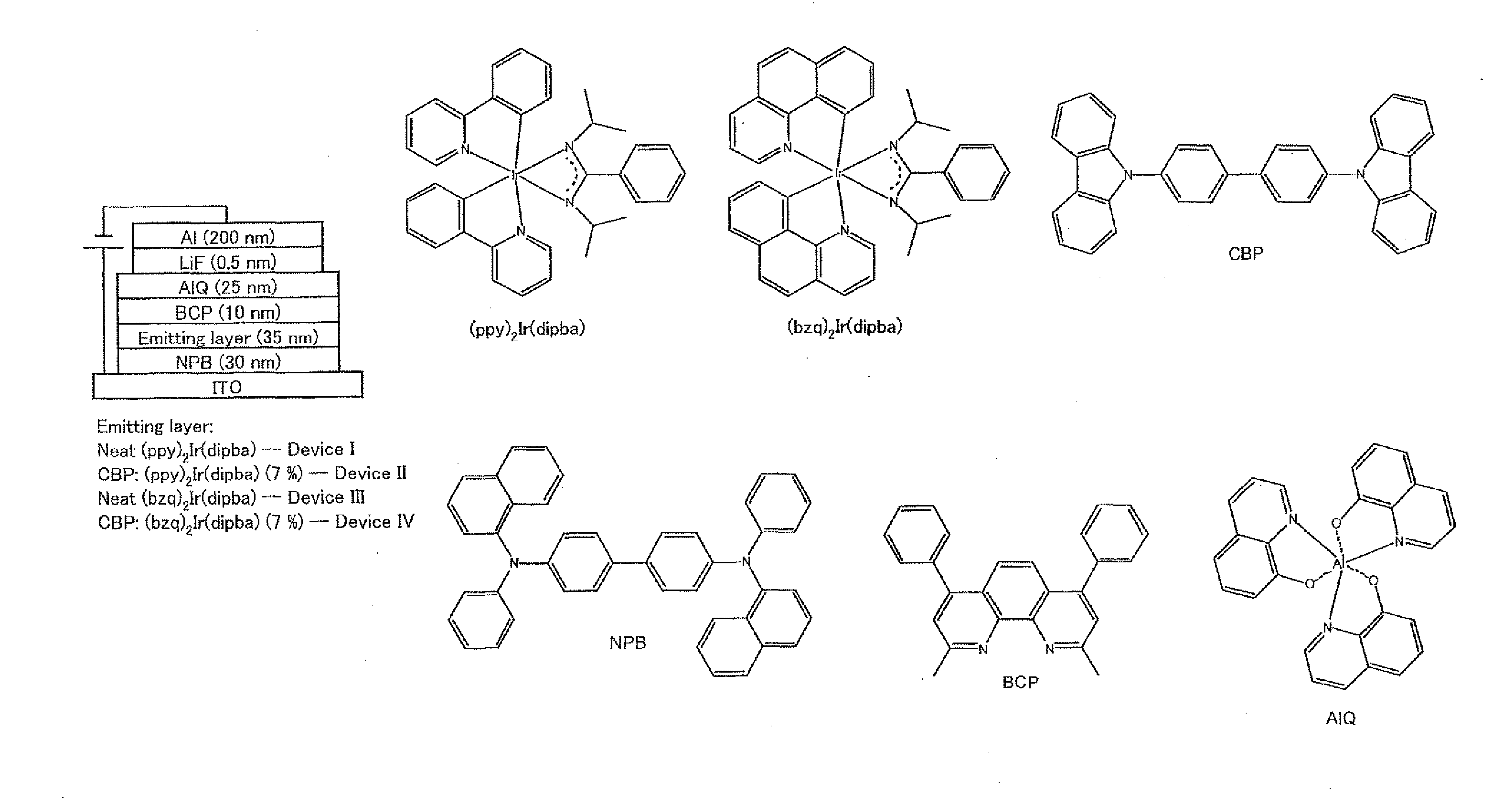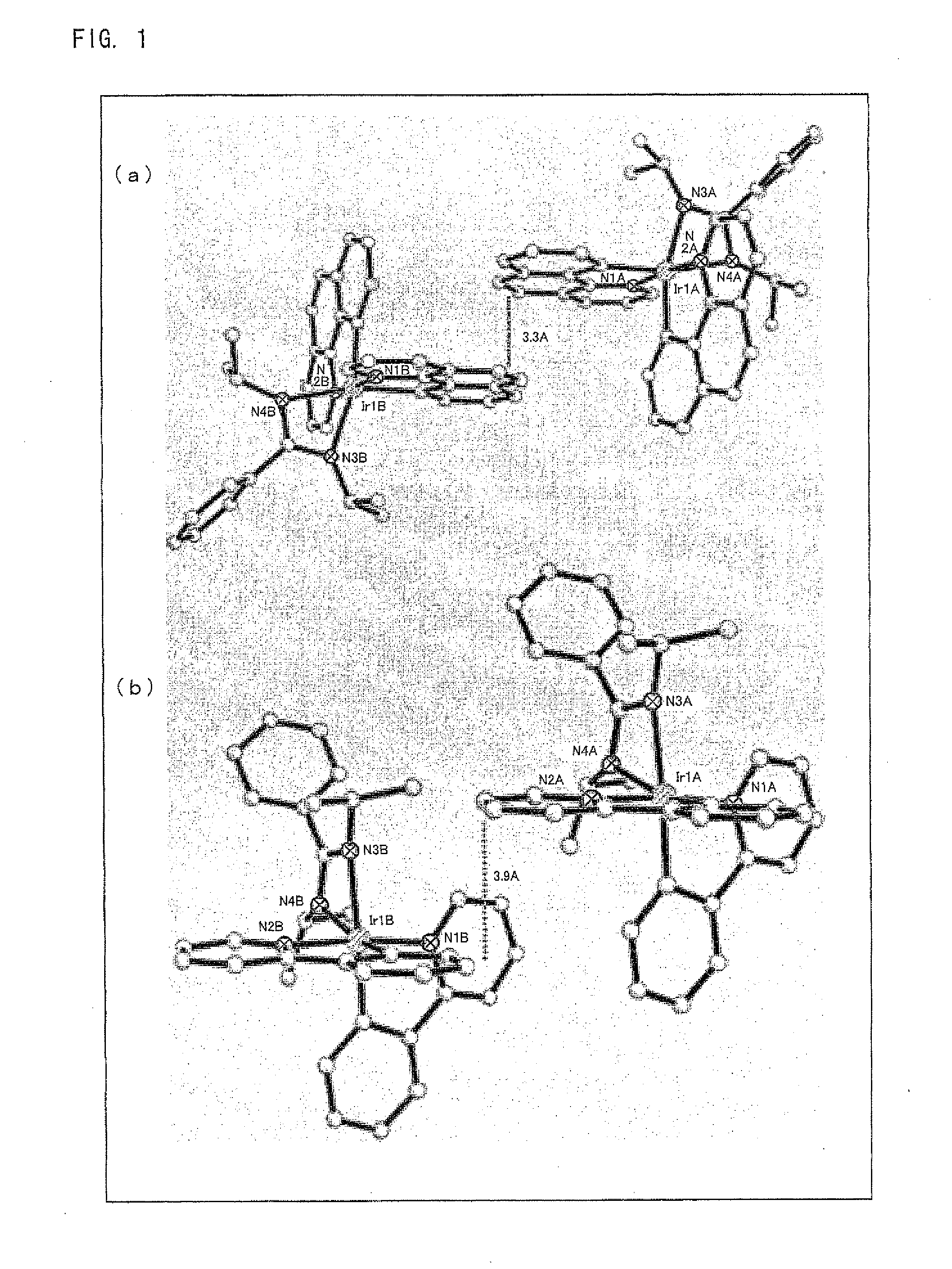Novel compound and use thereof
a technology of compound and compound, applied in the field of new compound, can solve the problems of poor charge transfer and phase separation between the luminescent host, and achieve the effect of sufficient light-emitting property
- Summary
- Abstract
- Description
- Claims
- Application Information
AI Technical Summary
Benefits of technology
Problems solved by technology
Method used
Image
Examples
example 1
Synthesis of (ppy)2Ir(dipba) and (bzq)2Ir(dipba), and Analysis of Structures Thereof
[0205](Overall of Synthetic Reaction)
[0206]Unless otherwise stated, commercially available materials were used without purification. Hexane to be used as a solvent for washing or synthesis was obtained in such a manner that sodium and benzophenone were caused to coexist with each other in nitrogen atmosphere, and anhydrous hexane was distilled. Glass apparatuses, syringes, magnetic stirrers and the like to be used in synthetic reaction were dried in a convection oven for at least four hours.
[0207]Monitoring of the synthetic reaction was performed by use of a thin-layer chromatography (TLC). More specifically, with the use of a commercially-available TLC plate (Silica gel 60 F254, made by Merck), a spot was observed under ultraviolet light at wavelengths of 254 nm and 365 nm. Purification of an iridium complex obtained by the synthetic reaction was performed by use of silica column chromatography in w...
example 2
Absorption, Photoluminescence (PL), and Electrochemical Measurement of (ppy)2Ir(dipba) and (bzq)2Ir(dipba)
[0225](Methods of Absorption, PL, and Electrochemical Measurement)
[0226](1) Electrochemical Measurement
[0227]The electrochemical measurement was conducted by use of BAS 100W Bioanalytical electrochemical work station (Bioanalytical Systems Inc, U.S). More specifically, the electrochemical measurement was conducted by cyclic voltammetry under such conditions that a platinum stick was employed as a working electrode, a platinum wire was employed as an auxiliary electrode, an Ag / Ag+ electrode having a core made of porous glass was employed as a reference electrode, a ferrocene / ferrocenium couple was used as a reference, and a scan rate was set to 100 mV / s. The measurement was performed in a CH2Cl2 solvent containing Bu4NPF6, which is an electrolyte, at a concentration of 0.1 mol / l.
[0228](2) Absorption Spectrum and PL Spectrum
[0229]The absorption spectrum was obtained by use of UV-2...
example 3
Production of OLEDs Using (ppy)2Ir(dipba) or (bzq)2Ir(dipba) and Measurement of Electroluminescence (EL)
[0251](Production of Non-Doped OLEDs)
[0252]In order to understand the light-emitting property of these iridium complexes according to the present invention, non-doped OLEDs (diodes in this example) I and III were produced by use of these complexes in the following manner. Initially, a glass substrate (sheet resistor: 20 Ω / cm2) of which one surface was covered with ITO (formed into an anode) was subjected to ultrasonic cleaning with ethanol, acetone, and detergent. Then, on the ITO film were thermally evaporated organic materials, i.e., (a) N,N′-diphenyl-N,N′-bis(1-naphthyl)-1,1′-diphenyl-4,4′-diamine (NPB), (b) an iridium complex (the (ppy)2Ir(dipba) for the OLEDs I, and the (bzq)2Ir(dipba) for the OLEDs III), (c) 2,9-dimethyl-4,7-diphenyl-1,10-phenanthroline (BCP), and (d) tris(8-hydroxyquinoline)aluminum (AIQ) in this order under a pressure of about 3.5×10−4 Pa and a rate of 1.0...
PUM
 Login to View More
Login to View More Abstract
Description
Claims
Application Information
 Login to View More
Login to View More - R&D
- Intellectual Property
- Life Sciences
- Materials
- Tech Scout
- Unparalleled Data Quality
- Higher Quality Content
- 60% Fewer Hallucinations
Browse by: Latest US Patents, China's latest patents, Technical Efficacy Thesaurus, Application Domain, Technology Topic, Popular Technical Reports.
© 2025 PatSnap. All rights reserved.Legal|Privacy policy|Modern Slavery Act Transparency Statement|Sitemap|About US| Contact US: help@patsnap.com



